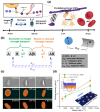Platelet Biorheology and Mechanobiology in Thrombosis and Hemostasis: Perspectives from Multiscale Computation
- PMID: 38732019
- PMCID: PMC11083691
- DOI: 10.3390/ijms25094800
Platelet Biorheology and Mechanobiology in Thrombosis and Hemostasis: Perspectives from Multiscale Computation
Abstract
Thrombosis is the pathological clot formation under abnormal hemodynamic conditions, which can result in vascular obstruction, causing ischemic strokes and myocardial infarction. Thrombus growth under moderate to low shear (<1000 s-1) relies on platelet activation and coagulation. Thrombosis at elevated high shear rates (>10,000 s-1) is predominantly driven by unactivated platelet binding and aggregating mediated by von Willebrand factor (VWF), while platelet activation and coagulation are secondary in supporting and reinforcing the thrombus. Given the molecular and cellular level information it can access, multiscale computational modeling informed by biology can provide new pathophysiological mechanisms that are otherwise not accessible experimentally, holding promise for novel first-principle-based therapeutics. In this review, we summarize the key aspects of platelet biorheology and mechanobiology, focusing on the molecular and cellular scale events and how they build up to thrombosis through platelet adhesion and aggregation in the presence or absence of platelet activation. In particular, we highlight recent advancements in multiscale modeling of platelet biorheology and mechanobiology and how they can lead to the better prediction and quantification of thrombus formation, exemplifying the exciting paradigm of digital medicine.
Keywords: biorheology; platelet activation; platelet adhesion; platelet margination; platelet mechanobiology; shear-induced platelet aggregation; thrombosis; von Willebrand factor.
Conflict of interest statement
The authors declare no conflicts of interest.
Figures





References
Publication types
MeSH terms
LinkOut - more resources
Full Text Sources
Medical
Miscellaneous

